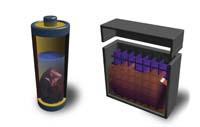Fugaz autonomy fleeting

What is the problem? Why is there no very resistant battery? There are two possible answers. The first is that yes, the batteries we currently use are very durable, but that has the same duration, that the user will always ask for more. The perfect battery should not charge. As long as it is not met, the user will request improvements.
Another answer is that a battery has many characteristics -- it's a duration- and, unfortunately, to improve one feature we must renounce another. The current battery provides without interruption the necessary energy. Small. Cheap. And it is not very dangerous.
Therefore, to improve the design of a battery, it is necessary to decide which of these characteristics is wanted to improve at the cost of which. Our starting point is sustainability. Well, the first thing you have to sacrifice to make a very durable battery, that is, a battery that does not need to recharge for a month, would be the size of the battery.
In short, batteries and batteries are a set of chemicals that generate electric current. By selecting suitable products, atoms of a product supply electrons to atoms of another product. In fact. Therefore, for the battery to operate longer, it is necessary to increase the quantities of both chemicals. In short, for the exchange of electrons to be prolonged it is necessary to introduce many electrons into the system, which means that large amounts of donor and recipient product are needed. But this generates a size problem: to increase the battery life it is necessary to increase the size. Contrary to what the market demands.
Small children Small children

The current mobile phones are thanks to batteries. They use very small batteries. And yet, the market demands that they be even smaller. In this sense, the markets of laptops and mobile phones are very different. Computers do not have a single battery, but a group of batteries. In mobile phones, on the contrary, the battery is unique and its size is more important.
One way to manufacture small batteries is to replace these chemicals. It seems a simple idea: to replace atoms that occupy little space for those who occupy much space. For this purpose it is necessary to find suitable small atoms.
This revolution came about twenty years ago. Until then, nickel and cadmium or nickel and hydride metal batteries predominated. A substitute for these systems, a new technology, was invented. The most important change was the size of the electrolyte; nickel-based batteries used potassium hydroxide as a source of ions, while in the new batteries a small atom was used: lithium. Being small, lithium ions give much more power to the battery.
Lithium predominates
The revolution has been very big. The first lithium ion batteries were launched in 1991 and have now colonized the field of conventional electronic devices. Test the battery of the mobile phone, GPS, PDA, computer, camera, etc. Almost all conventional electronic devices have a lithium-ion battery.
Lithium-based chemistry presents important advantages compared to that based on the niquel-cadmium system. On the one hand, for the same size, lithium ion battery provides higher potentials and energy densities than the other. On the other hand, it has no memory effects, that is, although it is loaded without full discharge, the battery does not lose capacity (for the cadmium nickel batteries to function properly it is necessary to download them completely and load them completely in each cycle, but not lithium ion). In addition, lithium ion batteries lose very little charge while not being used, unlike those of cadmium nickel.

Apparently all are advantages, so in today's small batteries, which require portable electrical appliances, lithium technology predominates. But it has not always been so. In the articles until three years ago, after explaining the advantages of lithium, a question was emphasized: "So why don't we see these batteries on all devices?" The problem was security.
Chemicals know that lithium is a dangerous metal. Very reactive. It is inflated only in contact with the air. Nitrogen storage is not a good idea, there are hardly any elements that react with nitrogen gas, but lithium reacts.
The cathode of most batteries is formed by a cobalt oxide. It is an appropriate material but degrades above the 160C, releases oxygen that reacts very quickly with lithium and inflates. In addition, the battery contains flammable organic solvents. This mixture is a small pump. It is not a joke: they have been explosions.
Between 2003 and 2006 there are the biggest problems with lithium batteries in the market. There, mobile phones, laptops, etc. They burned, after a fire or explosion of batteries.
By explosions or risk of explosion, HP, Dell, Toshiba, Sony, Sanyo, Nokia, LG and other manufacturers had to remove thousands of tools from the market. For example, it was heard periodically "Toshiba has asked 340,000 users who have acquired portable computers with battery of this type of model to return their tools".
Time of security

The current situation is not the same. In the last two years, much research has been done to ensure the safety of batteries. Therefore, the issue of explosions is overcome and the lithium ion has colonized the battery market. How? Well, especially thanks to electric circuits.
The batteries were mainly heated in the loading and unloading processes. The manufacturers realized that it was an electrical problem. And the solution could also be electric. A safety circuit was added, in short, a switch. If the temperature increases above 90C or the difference in potential above 4.3 volts, the circuit interrupts the flow of electricity.
This problem has been solved by the circuit and yet this study has not concluded. In recent times, the problem has also been analyzed from a chemical point of view: cobalt oxide can be replaced. They have sought a material that needs more than 160 C to degrade. With some manganese compounds, the safety distance increases by 20 C. And with some phosphates, 50 C more than with cobalt oxide. As a counterpart, energy density is lost, since cobalt oxide cathodes are those that accumulate higher energy density.
For the moment, cobalt oxide predominates in the cathodes of lithium ion batteries that we use, but soon the new materials could replace the cobalt. Phosphate, for example, was first tested in 1997 and phosphate batteries have already been marketed. The batteries are safer and also the phosphate is cheaper than cobalt oxide.
Last, polymers
The investigation of materials has also incited in a different scope to that of safety: size. Lithium is small and it is difficult to find a smaller electrolyte, but there is the possibility to reduce the area in which this electrolyte moves. Instead of immersing yourself in an organic liquid in a filamentous solid, thinner batteries can be made. With this idea are born lithium ion batteries with polymer support, lithium polymer batteries.

What is lost in this case? As is logical, when using a solid instead of a liquid, the mobility of the electrolyte is lost. Polymer is not a rigid solid but a gel, and yet it is the problem of mobility. Consequently, the battery does not provide as much voltage as conventional lithium ion. Instead of 3.7 volts, the lithium polymer is around 3.4.
It is not a big reduction, but it must be taken into account that this technology must respond to the dance of the market. As the research of batteries advances, the market has also evolved. In the case of laptops, batteries have not changed so much because they have advanced with a standard. On the contrary, mobile phones, besides being smaller and smaller, offer more and more resources: Capacity of Internet connection, extension and improvement of screens, etc.
The market demands more powerful batteries, not only more sustainable and small. And to meet this need, he expects the next battery revolution.



Buletina
Bidali zure helbide elektronikoa eta jaso asteroko buletina zure sarrera-ontzian











